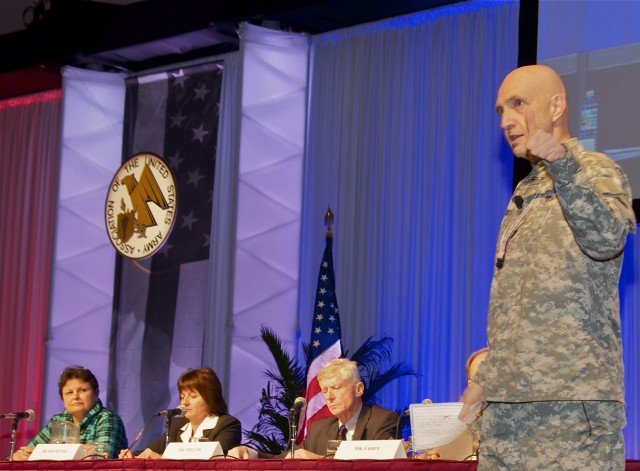
Fort Lauderdale, Fla. (Feb. 24, 2010) -- Some of the Army's top science and technology leaders said they are changing how they think and act so they can transfer new technology solutions to Warfighters at the speed Soldiers themselves are facing an evolving threat on the battlefield.
The conversation took place during at panel discussion at the Winter Association of the U.S. Army conference here.
U.S. Army Research, Development and Engineering Command Commander Maj. Gen. Nick Justice led the panel, which included the directors of RDECOM's research laboratory, the tank-automotive center, Soldier center, along with a representative of the Program Executive Office community. The panel spoke to, and answered questions for, an audience of hundreds of Soldiers, civilian employees and defense industry representatives.
"What we're trying to do is be agile and innovative and have the discipline we find in our organizations out there on the battlefield," Justice said.
"A Solider's life, a young infantryman's life, is far more complex than when I was a young infantryman," Justice said. "What they have to be to be successful changes from moment to moment, so our support to the Soldier has to track that. We have to be nimble and responsive to those young Soldiers doing great things on the battlefield."
Providing nimble support means looking at every level of how Army science and technology is done, the panelists said. Army technology begins at the Army's laboratories, which produce basic technologies like new armor materials, as well as partnering with others doing basic research the Army can use.
Those technologies then progress up a technology ladder through the RDECOM centers to Program Managers who shepherd a particular piece of equipment through the final phases and then to the field. Collaboration takes place along the way with academic researchers, industry, international partners and others. There are gates, checks and balances and other processes built into the system to keep costs down and developers focused on battlefield needs.
The system has provided the U.S. Army with the best technology in the world, but waiting for the system to work isn't good enough any more , said Dr. Grace M. Bochenek, director of RDECOM's Tank-Automotive Center in Warren, Mich.
"What we're thinking about here is how we behave, how we act together to get the solutions that we need," Bochenek said.
"So one of the things that I think we can do better is to go back and work with the people who write the requirements and help them articulate those requirements and capabilities that they're looking for. It's not a linear process, it's continuing dialogue and evolution that I think can help a lot," she said.
One addition to that dialog is the introduction of combat veterans to critical places in the development process of new equipment.
"The Army thinks this is so important they are giving me combat Soldiers in the Research, Development and Engineering Command to do some of this work," Justice said. "We will have senior noncommissioned officers who have three, four, five combat tours under their belts."
"They are not coming to be subject matter experts, but to partner with my directors and my scientist and engineer officers in uniform to bring their reality to what we do. What an awesome power to have, a squad of senior noncommissioned officers who are all combat veterans and have counterparts down in the school houses and can translate at that non-commissioned officer of detail. Engineering is about detail, and there's no better place to look at detail than in our non-commissioned officer ranks," he said.
Bringing the warfighters into the system is appropriate, he said, because the changes to the research, development and engineering community are driven by the changes the warfighters have made.
"We turned our Army into a modular, expeditionary force. Inherent in that is a list of requirements that our Army is learning to embrace and working to understand."
"One part of that is that we no longer do we look to buy and end device. Now we look to buy an integrated solution. And we need to design to modernize, not design the perfect product today. We know the requirements are going to change, so we need to build change into our products and into the Army organizations that produce those products." Justice said.

Social Sharing